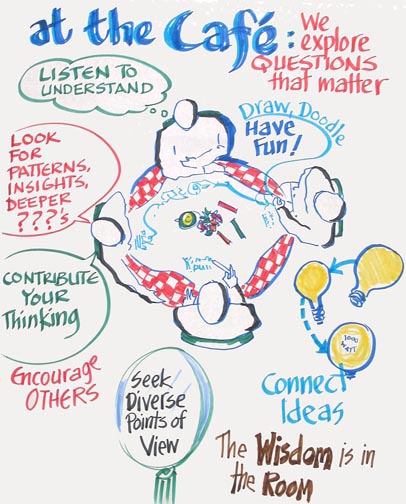30 Creating Synergy with World Cafes
“Imagine a community table big enough to serve an international community of active, curious learners who use the power of meaningful conversation for creating positive change in the world.” The World Cafe.com
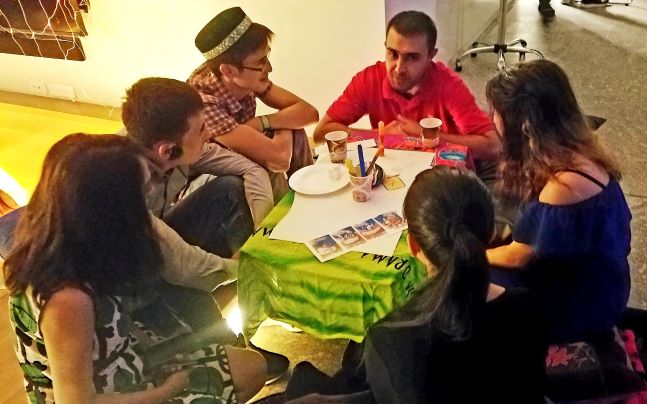
The World Cafe is becoming a full-fledged movement in the organizational change arena, and can be adapted to many different groups and situations. Juanita Brown and her partner, David Isaacs, created the World Cafe engagement process in the early 1990s and it is living up to its name as it is now being used in many institutions around the globe. Based on the concept that good conversations often happen in coffee shops or over a cup of tea, the world cafes create welcoming spaces where people can relax and talk in depth about important topics.
At the University of Central Asia in Kyrgyzstan and Tajikistan and at Selkirk College in British Columbia, Canada, world cafes have been used to deepen community conversations around culture, mental health and community development. I recently used the world cafe methodology at an on-line Zoom conference to discuss Campus Mental Health for professionals at a middle-eastern student affairs conference. I also created on-line world cafes for team building workshops for two departments at the University of Toronto when people were still working from home during the COVID pandemic. It is an adaptable facilitation strategy that can work for groups of 12 – 300 and is very effective at creating connections and generating creative ideas.
Purpose
World Cafes are designed to bring participants together to discuss meaningful topics. The format allows ideas to travel around the room because the participants have the opportunity to engage with three different dialogue tables. The purpose is to engage in deep conversations that can lead to creative ways of approaching issues of concern to the group.
Learning Objectives
Participants will
- Listen with respect and interest to the opinions and feelings of people at their table.
- Share their ideas, stories and solutions.
- Capture key insights on paper at each cafe table.
- Search for patterns, insights and creative approaches to the issues being discussed.
- Contribute to the final “harvest” of key ideas that could move towards actions in their communities.
World Café Guidelines:
Conducting an exciting World Café Conversation is not hard—it’s limited only by your
imagination! The World Café format is flexible and adapts to many different circumstances.
When these design principles are used together they foster collaborative dialogue, active
engagement, and constructive possibilities for action.
1) Set the Context
Pay attention to the reason you are bringing people together, and
what you want to achieve. Knowing the purpose and parameters
of your meeting enables you to consider and choose the most
important elements to realize your goals: e.g. who should be
part of the conversation, what themes or questions will be most
pertinent, what sorts of harvest will be more useful, etc..
2) Create Hospitable Space
Café hosts around the world emphasize the power and importance
of creating a hospitable space—one that feels safe and inviting.
When people feel comfortable to be themselves, they do their
most creative thinking, speaking, and listening. In particular,
consider how your invitation and your physical set-up contribute
to creating a welcoming atmosphere.
3) Explore Questions that Matter
Knowledge emerges in response to compelling questions. Find
questions that are relevant to the real-life concerns of the group.
Powerful questions that “travel well” help attract collective energy,
insight, and action as they move throughout a system. Depending
on the timeframe available and your objectives, your Café may
explore a single question or use a progressively deeper line of
inquiry through several conversational rounds.
4) Encourage Everyone’s Contribution
As leaders we are increasingly aware of the importance of
participation, but most people don’t only want to participate, they
want to actively contribute to making a difference. It is important to
encourage everyone in your meeting to contribute their ideas and
perspectives, while also allowing anyone who wants to participate
by simply listening to do so.
© 2015 The World Café Community Foundation
Creative Commons Attribution
Free to copy & distribute w/acknowledgement & link: www.theworldcafe.com
World Cafe Directions
One month ahead of time:
- Meet with stake holders to design overall goals and brainstorm powerful questions for the three rounds of discussion.
Tips for Designing Juicy Questions: In three rounds of a world cafe, we usually start with something that defines the issues and helps participants get to know each other better. The second round often explores some of the challenges, obstacles and emotional connections to this issue. The last round is usually future oriented with participants discussing ideas for action or moving forward on ideas that have been discussed. See Case Studies below to see examples of questions used in different settings.
2. Invitation list: Create the invitation list with an intention to include diverse voices that might bring fresh ideas and creativity to the dialogue.
3. Recruit Volunteers: Create committee of volunteers to help with facilitation and setting up and decorating the room so it resembles a welcoming cafe.
4. Find a venue: Book room that is big enough for proposed group.
5. Identify cafe furniture: Find small cafe style tables and chairs that can be used to create the cafe ambience.
6. Invite Performers: If including performers, ask musicians or poets and confirm and find out their performance needs for space, speakers, mics etc.
7. Send invitations and registration link with a deadline so you know how many tables you need.

One Week Ahead of Time
- Confirm list of participants so you have the right number of tables, snacks and tea.
- Gather table cloths (sometime have used red and white French Cafe style cloths or a variety of scarves and cloths that can cover the tables).
- Organize markers and paper for each table.
- If having snacks or tea, confirm table ware, food and set-up details.
- Book and confirm speaker/mics
- Conduct short training for volunteer hosts on their roles as table hosts.
- Assign one volunteer to be the Maitre’D who will greet guests and lead them to their tables
World Cafe Day:
- Set up your cafe to create a warm and welcoming atmosphere. Decide where the cafe host will stand so they can easily hand their mic to people at tables to contribute to the large group discussions.
- Check that each table has chart paper and a jar with 5-6 coloured markers.
- Organize live or streamed cafe music to be playing as people arrive. At some world cafes, we have also had poets, singers and musicians that play between the rounds of questions and again play at the very end so that people can stay to continue the conversations in an informal setting.
Flow of Events During the Cafe:
- Welcome everyone and explain the purpose of world cafes and your particular theme.
- Ask each group to identify a host. This person will stay at the same table for the entire event. Some cafes appoint these hosts ahead of time and give them “hosting” training. Other event coordinators, ask each table to find a volunteer host that wants to stay at their table and welcome the newcomers. When a World Cafe was hosted in a Senior Citizens Residence, the person at the table with the most mobility issues (wheel chairs and walkers) stayed at the table as host, and those with better mobility moved to new tables.
- Explain the cafe etiquette:
- Contribute your thinking and experience
- Listen to understand,
- Connect Ideas and
- Listen Together for patterns, insights and deeper questions.
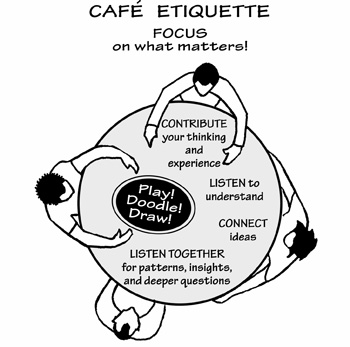
- First Dialogue: Introduce the first question. Let groups know they will have 20 minutes to discuss this questions. Encourage them to use the chart paper and pens on the table to doodle, draw and write down some of the key ideas being discussed.
- Popcorn reflections: (short, pithy insights). After 20 minutes, bring the attention back to the facilitator. Ask whether a few people could share some brief comments what struck them from their group conversation. (keep these full group check-ins to 10 minutes).
- Host stays, everyone else finds a new table. Ask the hosts to stay at their tables, but everyone else should leave and find a new table to sit with new people. If you have live performers, have musicians or poets perform one piece between the different coversation rounds.
- Second Dialogue: When everyone is settled at their new tables, introduce the second question. Ask the host to summarize the earlier discussion and explain any of the notes or drawings on the page. The new participants add more layers of ideas and doodles onto the paper that is on the table.
- Popcorn Insights and move to Third Dialogue: After 20 minutes repeat Steps #2 and #3 then introduce the third question. This question is usually action and future oriented.
- Harvest of Ideas: After the round three group has been talking for 20 minutes, distribute large sticky notes or coloured pieces of paper for people to write down their main ideas for moving forward with ideas or actions related to the issue being discussed.
- Gallery Walk: Stick the chart papers full of drawings and ideas on the wall and have one section where all the sticky notes with solutions and action items can be clustered. Invite everyone to take a gallery walk to look at the posters and ideas.
- Final Reflections: When people are seated, do one final round of “pop up” conversations where 4 to 6 people share the ideas that have inspired them. Finish by asking a few people for reflections on their experience of the cafe as a whole. What are they taking home with them?
- Gratitude and Closure: Thank everyone and tell them you will be sending them a summary of the harvested ideas from the sticky notes and chart papers.
Case Study#1
University of Central Asia, World Campus Culture Cafe Questions, Kyrgyzstan
60 participants including students, staff and faculty
Round One:
What cultures do you belong to? What are some of the traditions, taboos and ethics in the cultures you belong to? What do you value about these cultures?
Round Two:
What are your experiences of diversity and inclusion at our university? What challenges have you experienced or observed in terms of us creating an inclusive and welcoming culture?
Round Three:
If people walked into our campus and thought our campus was a great prototype for a pluralistic society, what would they be noticing and feeling? What ideas do you have to continue deepening a culture of belonging and inclusion on our campus?
Case Study #2
On-Line Zoom World Cafe for University Counsellors in the Middle-East (2021)
Round One:
As we continue to live and work in this world pandemic, what are some of the mental health challenges you are observing in both your students and colleagues?
Round Two:
As a counselling professional working on-line these days dealing with crises and supporting many struggling students, what do you do to maintain your own mental health and well-being?
Round Three:
As we prepare for students returning to campus and think of the future, what ideas do you have to promote mental health and well-being for your campus communities?
Case Study #3
Lakeside Living Residence, Salmon Arm, British Columbia. Canada, (Senior Citizens aged 80 – 95)
Round One:
Over the course of your life, where is one place that you have spent time that is special to you? What is is about that place that is meaningful for you?
Round Two:
How did you come to be living in the town of Salmon Arm and what do you like and dislike about living here?
Round Three:
What is something that has happened in your life that you feel proud of?
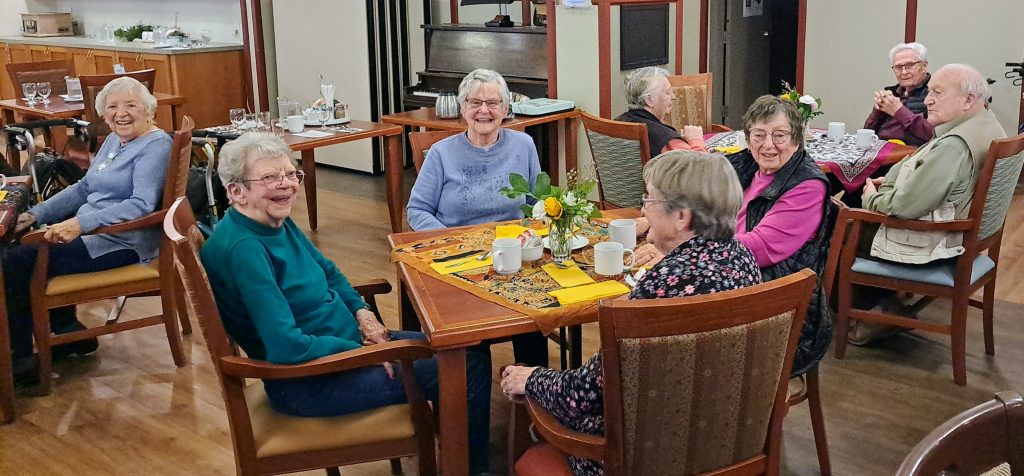
Online Adaptation:
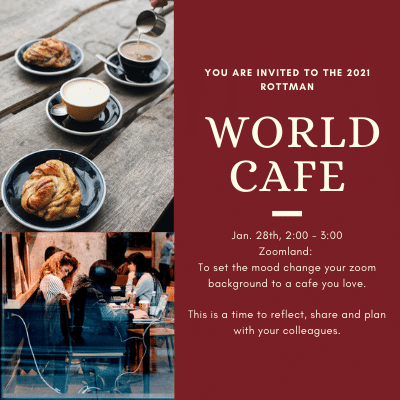 The World Cafe works surprisingly well on-line. It does not have the ambience of a cafe, but using the format of three break-out groups interspersed with the full group debriefings, is effective for getting groups talking with different members and generating new ideas. During the covid pandemic, zoom world cafes were a way to bring departments together to check in, share their challenges and successes and brainstorm ways to work together. To give the feeling of a cafe, we invited all participants to have their favourite cafe as their personal zoom back drop and to bring a favourite mug to the zoom cafe. The first round of questions involved sharing the story of their favourite mug and/or cafe and why they were special to them. This personal question helped people get to know each other and bridged into the more complicated questions around mental health and wellbeing for both themselves and their students.
The World Cafe works surprisingly well on-line. It does not have the ambience of a cafe, but using the format of three break-out groups interspersed with the full group debriefings, is effective for getting groups talking with different members and generating new ideas. During the covid pandemic, zoom world cafes were a way to bring departments together to check in, share their challenges and successes and brainstorm ways to work together. To give the feeling of a cafe, we invited all participants to have their favourite cafe as their personal zoom back drop and to bring a favourite mug to the zoom cafe. The first round of questions involved sharing the story of their favourite mug and/or cafe and why they were special to them. This personal question helped people get to know each other and bridged into the more complicated questions around mental health and wellbeing for both themselves and their students.
Padlet can be used for the last round for people to share insights, ideas, action items and general feedback on the world cafe event.
Resources and Materials Needed:
- Enough tables for 4-5 people to sit at each table
- Chart paper on each table
- Coloured markers in glass on each table
- Coloured sticky notes to put on wall for final harvest of ideas
- Table cloths, snacks and flowers can help to set the mood and transform the room into feeling like a cafe where people engage in relaxed conversations
- Sound system with wireless mic so facilitator can move around the room hearing ideas
References and Learn More:
Full directions on developing questions and hosting great conversations:
Another Example of table etiquette posters taped to the wall and/or a small version placed on each cafe table.
